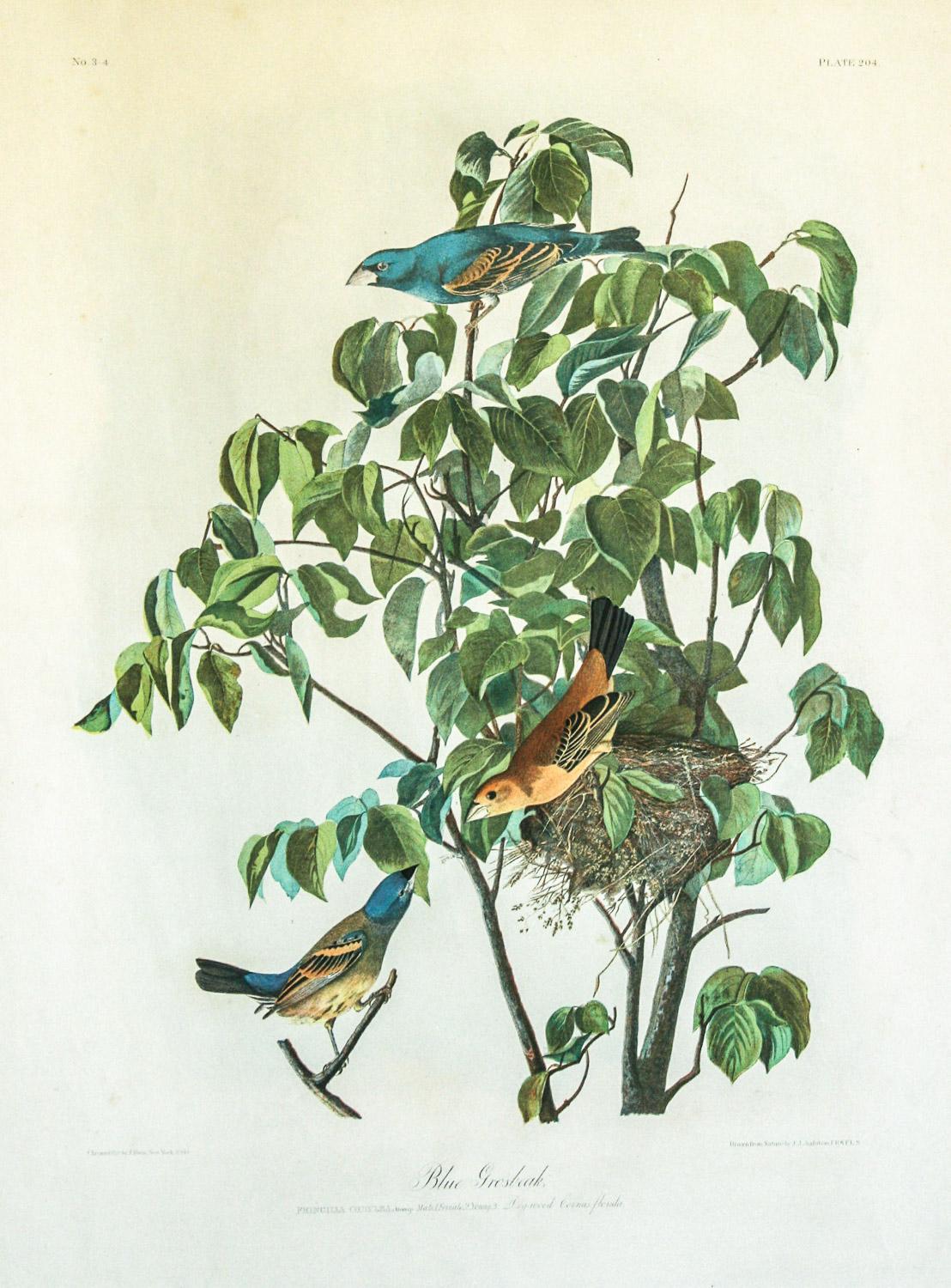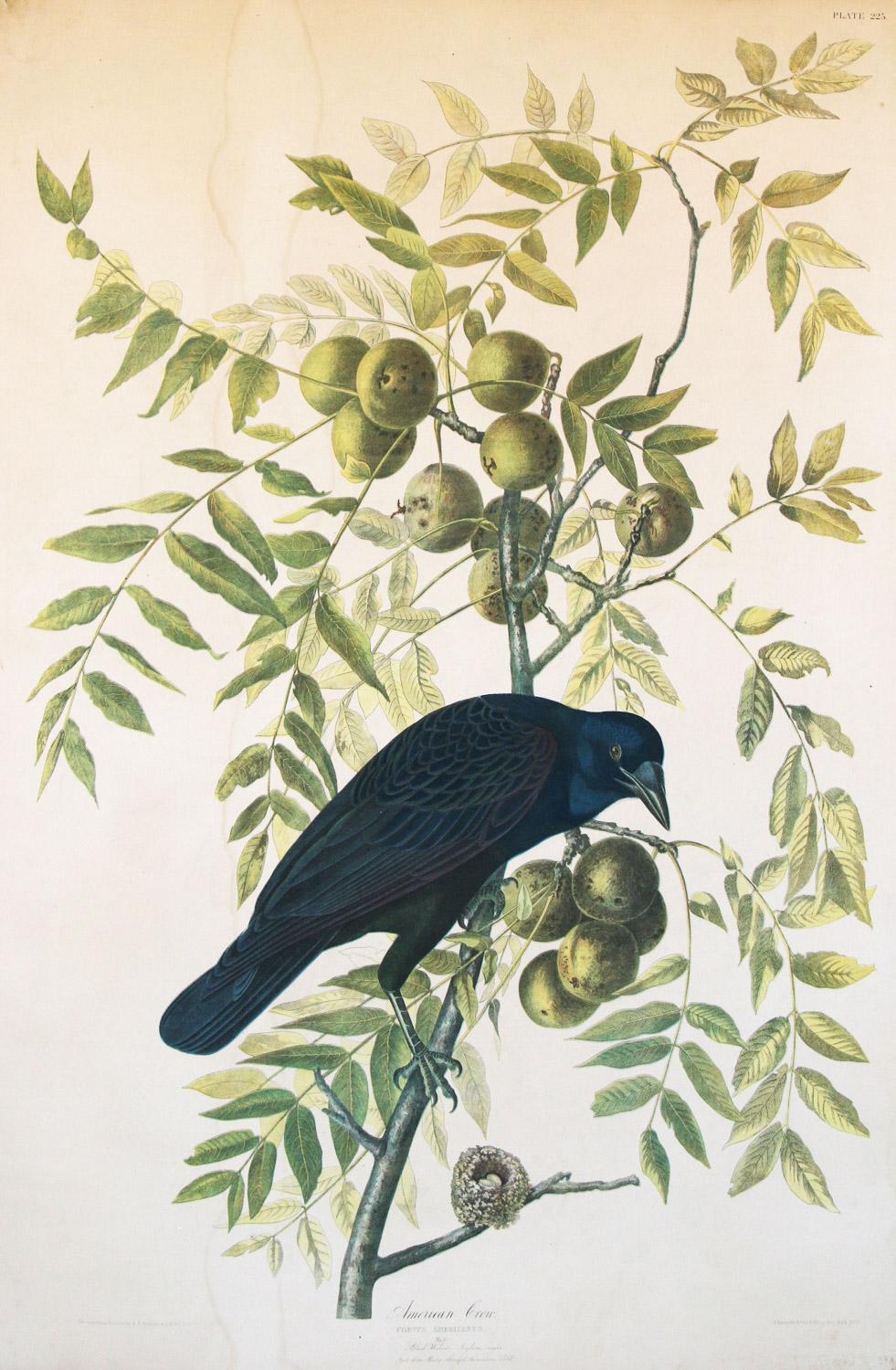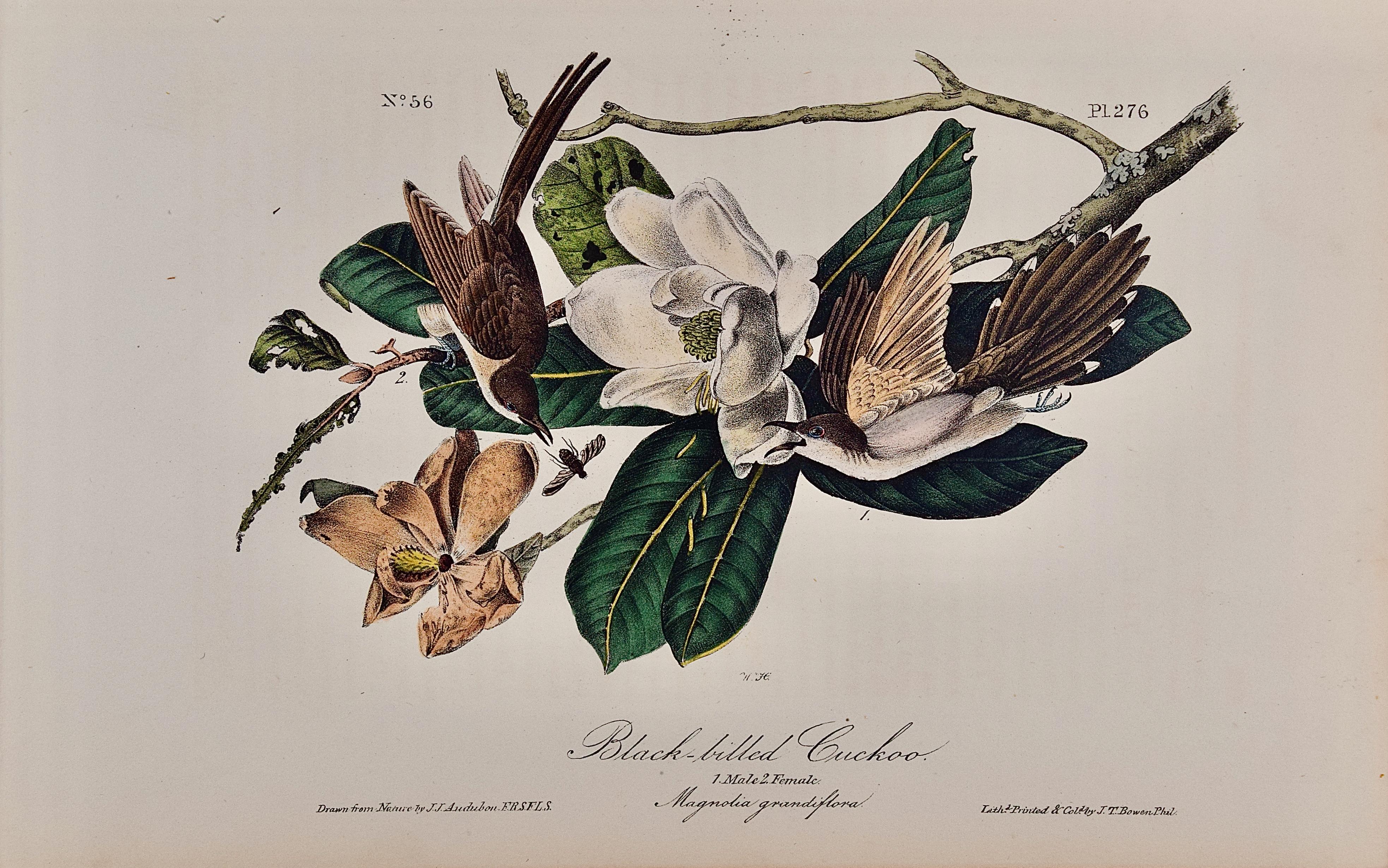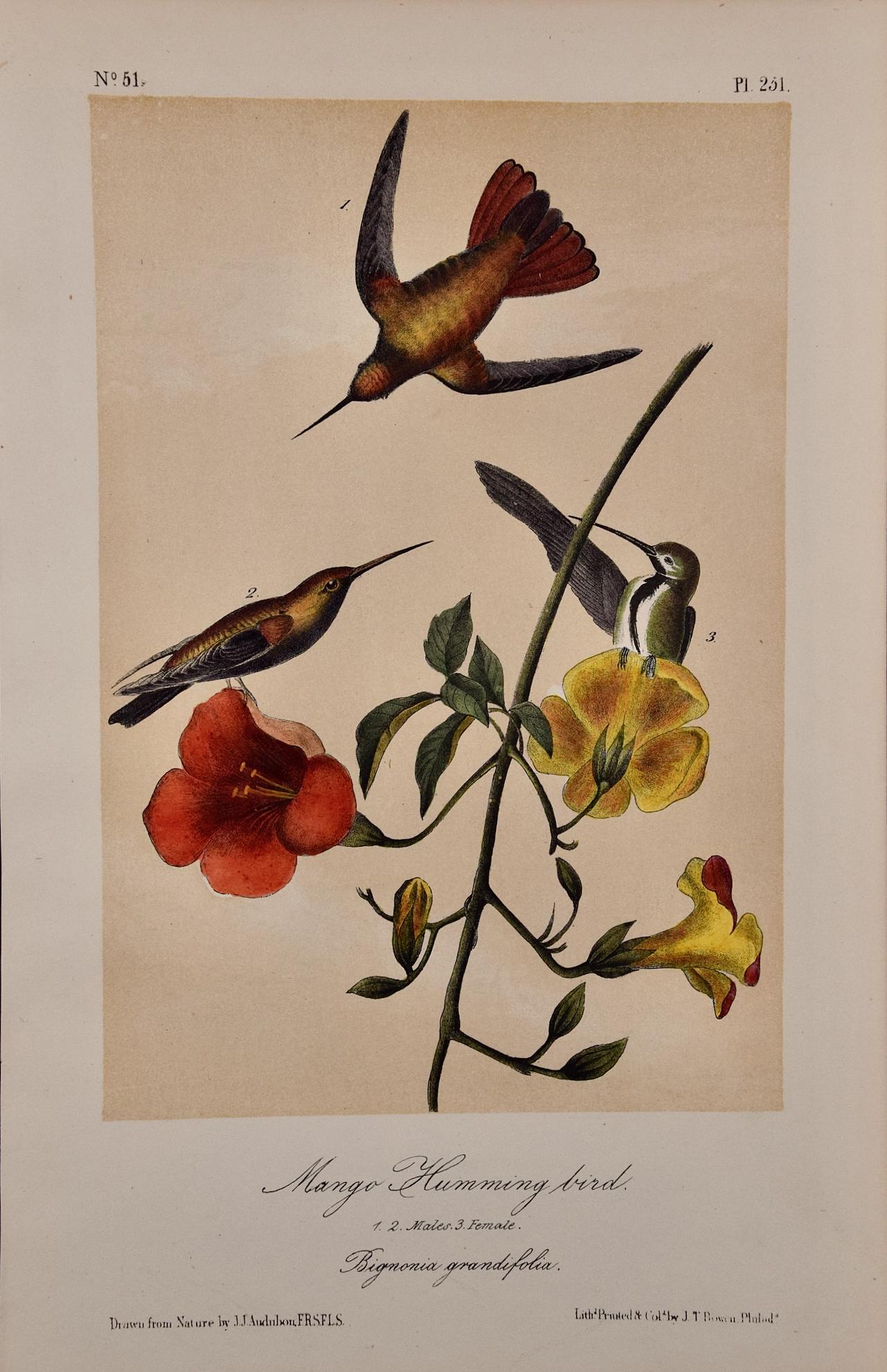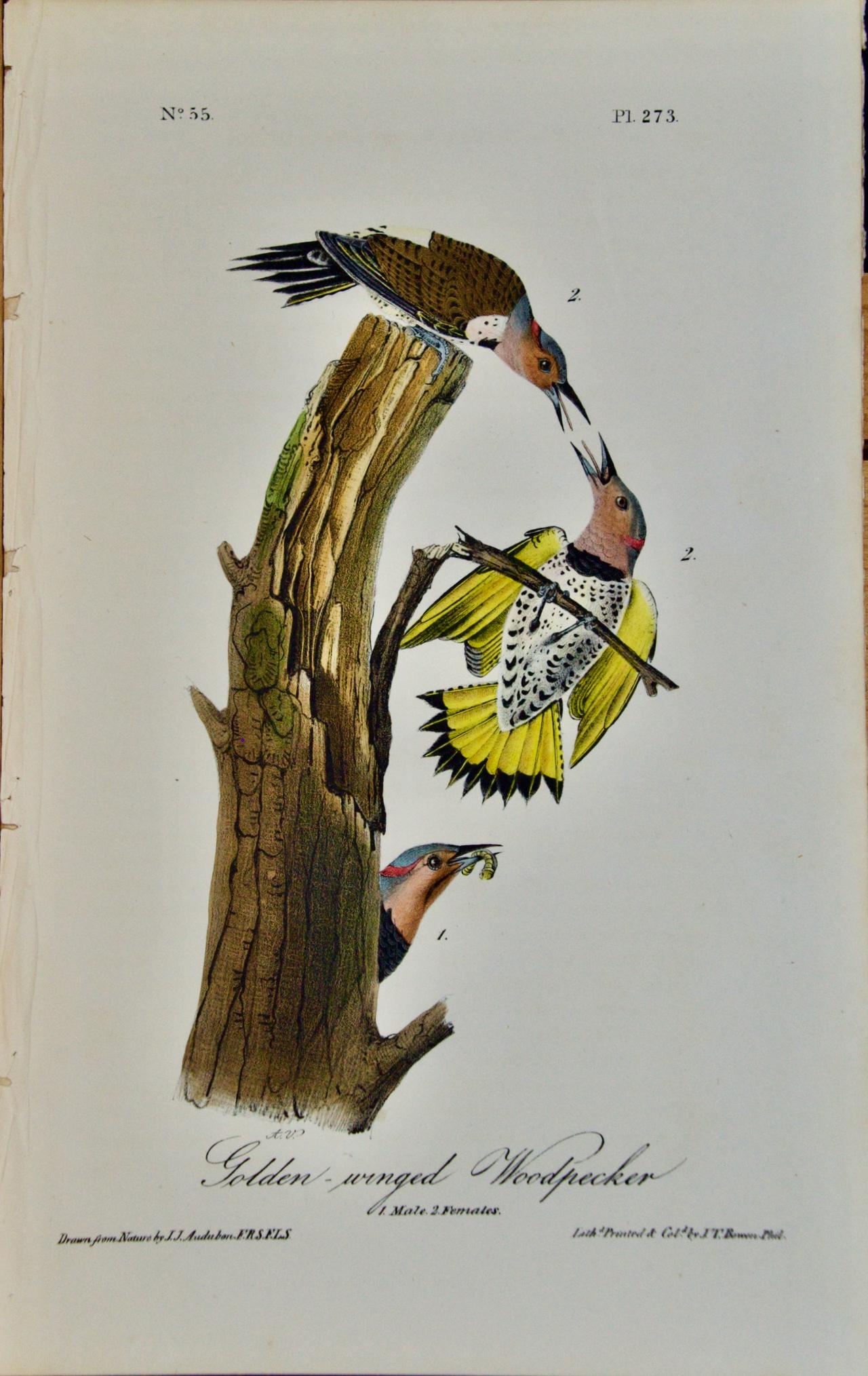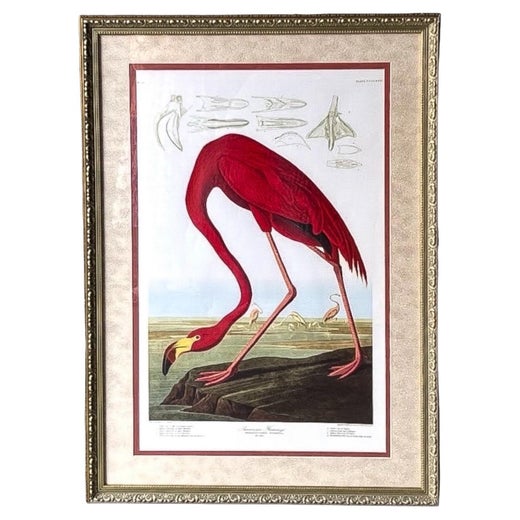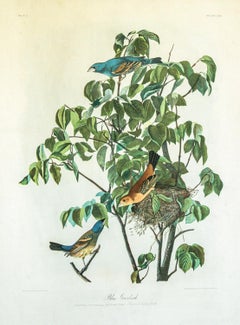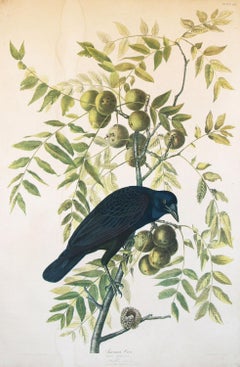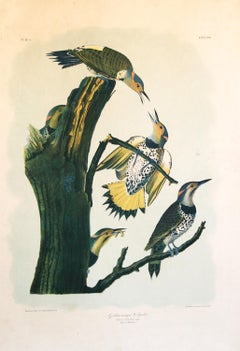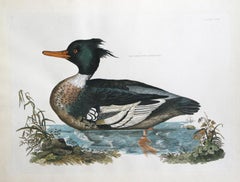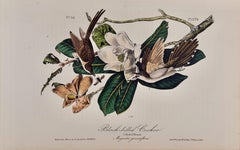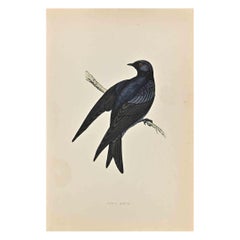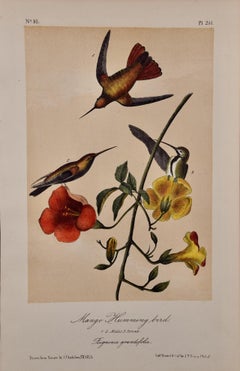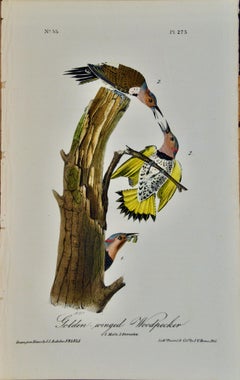Items Similar to Purple Martin Bien Ed. J.J. Audubon rare hand colored chromolithograph
Want more images or videos?
Request additional images or videos from the seller
1 of 5
John James AudubonPurple Martin Bien Ed. J.J. Audubon rare hand colored chromolithograph1858-1860
1858-1860
$8,250
£6,243.97
€7,169.33
CA$11,752.81
A$12,746.20
CHF 6,694.79
MX$154,825.06
NOK 83,774.69
SEK 78,878.55
DKK 53,523.99
About the Item
Two adult Purple Martins are feeding their two fledglings at the nest. This chromolithograph is from The Birds of America by John James Audubon and is considered to be the single greatest ornithological work ever produced. In 1858, seven years after the death of his father, John Woodhouse Audubon decided to re-issue this great set of prints. Julius Bien, as printer for the second edition, used the newest and most modern technique of the time, chromolithography, and printed what is considered to this day to be one of the finest examples of this process. Of the original set of 435 images only about 150 plates and 100 sets, for what is known as the Bien Edition, was completed when printing was interrupted by the onset of the Civil War. The Bien edition of the Birds of America , printed by an American publishing house and very limited in availability, is a rare and great addition to any bird lovers collection. This print is in very good condition with a couple of very small tears in the margin.
- Creator:John James Audubon (1785-1851, American, French)
- Creation Year:1858-1860
- Dimensions:Height: 39.5 in (100.33 cm)Width: 26.5 in (67.31 cm)Depth: 0.07 in (1.78 mm)
- Medium:
- Period:
- Condition:
- Gallery Location:Paonia, CO
- Reference Number:1stDibs: LU78032531031
John James Audubon
John James Audubon (April 26, 1785, Les Cayes, Saint-Domingue (later Haiti) – January 27, 1851 (aged 65) Manhattan, New York, U.S.), born Jean-Jacques Audubon, was an American ornithologist, naturalist, and painter. He was notable for his expansive studies to document all types of American birds and for his detailed illustrations that depicted the birds in their natural habitats. His major work, a color-plate book entitled The Birds of America (1827–1839), is considered one of the finest ornithological works ever completed. Audubon identified 25 new species.
About the Seller
4.9
Gold Seller
Premium sellers maintaining a 4.3+ rating and 24-hour response times
Established in 1978
1stDibs seller since 2017
128 sales on 1stDibs
Typical response time: 2 hours
- ShippingRetrieving quote...Shipping from: Paonia, CO
- Return Policy
Authenticity Guarantee
In the unlikely event there’s an issue with an item’s authenticity, contact us within 1 year for a full refund. DetailsMoney-Back Guarantee
If your item is not as described, is damaged in transit, or does not arrive, contact us within 7 days for a full refund. Details24-Hour Cancellation
You have a 24-hour grace period in which to reconsider your purchase, with no questions asked.Vetted Professional Sellers
Our world-class sellers must adhere to strict standards for service and quality, maintaining the integrity of our listings.Price-Match Guarantee
If you find that a seller listed the same item for a lower price elsewhere, we’ll match it.Trusted Global Delivery
Our best-in-class carrier network provides specialized shipping options worldwide, including custom delivery.More From This Seller
View AllBlue Grosbeak original chromolithograph by J.J. Audubon Bien edition 1860
By John James Audubon
Located in Paonia, CO
Blue Grosbeak is an original chromolithograph from the rare Bien edition 1860 by J.J. Audubon and shows a male and female adult Grosbeak with a young Grosbeak perched on the edge of the nest. This group of colorful birds are seen on a Dogwood cornus florida tree. This print is in good condition. The paper is evenly age toned throughout.
The ” Birds of America” by John James...
Category
1860s Other Art Style Animal Prints
Materials
Lithograph
American Crow 1858 Chromolithograph by J.J. Audubon Plate, Julius Bien Edition
By John James Audubon
Located in Paonia, CO
American Crow by J.J. Audubon from his Birds of America folio shows an adult male crow in a Black Walnut bush with a nest of a Ruby-Throated Hummingbird in a branch below the crow. This original chromolithograph plate no. 226 is in good condition with a repairable water mark in the image on the left side as can be seen in the photos.
The ” Birds of America” by John James...
Category
1850s Naturalistic Animal Prints
Materials
Lithograph
Golden Winged Woodpecker by J.J. Audubon Bien Edition 1860
By John James Audubon
Located in Paonia, CO
The Golden Winged Woodpecker, Plate 273 Picus auratus, Linn. The current name, Northern Flicker, Colaptes auratus. is in good condition. The edges are ragged from age with small areas of paper missing in two places but only on the very edge.
The ” Birds of America” by John James...
Category
1860s Other Art Style Animal Prints
Materials
Lithograph
Red Breasted Merganser from Illustrations of British Ornithology Pl.58 by Selby
Located in Paonia, CO
Red Breasted Merganser PL 58 from a rare black and white edition of Prideaux John Selby’s two volume set of 222 engravings “Illustrations of British Ornithology”. These original...
Category
Mid-19th Century Realist Animal Prints
Materials
Engraving
[ Bird of Paradise] La Pie de paradise, vue par derriere, No.21
By Jacques Barraband
Located in Paonia, CO
[ Bird of Paradise] La Pie de paradise, vue par derriere , No.21, Paris 1801-1806 [Astrapia nigra]. Color-printed engraving with hand-coloring. French botanical and zoological illustrator Jacques Barraband (1767-1809) was known as one of the finest ornithological artists of his time .He is best known for his watercolors and engravings that were commissioned by François LeVaillant, French explorer, naturalist, zoological collector , noted ornithologist and author. Levaillant’s Histoire naturelle des perroquets (1801-05) and his Histoire naturelle des oiseaux de paradis (Birds of Paradise, 1801-06), both of which Barraband contributed to, are still considered some of the most beautiful bird books of all times because of their exceptional scientific accuracy, rich color and detail. The Astrapia nigra is a Bird of Paradise that inhabits the Vogelkop Peninsula of West Papua...
Category
Early 18th Century Other Art Style Animal Prints
Materials
Engraving
$5,200 Sale Price
20% Off
The Aurelian, A Natural History English Moths Butterflies Plate XXVII 1778 ed.
By Moses Harris
Located in Paonia, CO
Moses Harris ( British 1731-1785 )
The Aurelian, A Natural History of English Moths and Butterflies
Hand colored engraving – Plate XXVII
1778 edition
Plate XXVII is from The A...
Category
1770s More Prints
Materials
Engraving
You May Also Like
Black-billed Cuckoo: An Original 1st Ed. Audubon Hand-colored Bird Lithograph
By John James Audubon
Located in Alamo, CA
This is an original 1st octavo edition John James Audubon hand-colored lithograph entitled "Black-billed Cuckoo, 1. Male, 2, Female, Magnolia Grandiflora", No. 56, Plate 276 from Audubon's "Birds of America, lithographed, printed and colored by J. T. Bowen and published in Philadelphia between 1840-1844. It depicts a female black-billed cuckoo perched on a branch of a magnolia tree reaching for a flying insect. The male appears to be in flight in front of magnolia leaves on the right, perhaps after the same insect. Magnolia flowers are depicted, as well.
This original 1st octavo edition hand-colored Audubon Black-billed Cuckoo lithograph is in excellent condition, other than a few tiny spots in the upper margin and a tiny faint spot in the lower inscription area. The sheet measures 6.5" high by 10.13" wide. The original text pages, 300-302, from Audubon's 19th century publication are included with the lithograph.
John James Audubon (1785-1851) was a naturalist and artist. He was initially unsuccessful financially prior to the publication of his famous work “The Birds of America”, spending time in debtor’s prison, once stabbing a disgruntled investor in self-defense. However, his obsession with birds and art motivated him to persist in his goal of documenting every bird in America via his watercolor paintings and publishing his works for all to enjoy. Audubon's first illustrations were published in a large elephant folio size. Due to their expense they were purchased in rather small numbers by the wealthy. To reach a larger audience, Audubon, with the help of his sons and J. T. Bowen, published a smaller octavo sized lithograph version, which were much more affordable.
With the success of his bird projects, Audubon then turned his attention to four-legged animals. He explored the Missouri River in 1843 sketching the four-legged animals he encountered in their natural setting. His expedition covered some of the same regions recently explored by Lewis and Clark, traveling from present day Alaska to Mexico. Audubon realized that this was an opportunity to document these animals in the still relatively pristine American wilderness, before man encroached on their environment.
Between 1845 and 1848, Audubon and his sons John Woodhouse Audubon and Victor Gifford Audubon produced a set of elephant folio sized lithographs that were primarily engraved and hand colored by J. T. Bowen in Philadelphia. The publication, which included text descriptions of the animals was published 3 years before Audubon died. As with the birds, this was followed by a three-volume set of 155 octavo-sized plates entitled “The Quadrupeds of North America” completed and published by Audubon’s sons, John, Jr. and Victor.
Audubon prints continue to be popular and a wise investment. The double elephant folio set...
Category
Mid-19th Century Naturalistic Animal Prints
Materials
Lithograph
Purple Martin - Woodcut Print by Alexander Francis Lydon - 1870
Located in Roma, IT
Purple Martin is a modern artwork realized in 1870 by the British artist Alexander Francis Lydon (1836-1917).
Woodcut print on ivory-colored paper.
Han...
Category
1870s Modern Figurative Prints
Materials
Woodcut
Mango Hummingbirds: An Original 19th C. Audubon Hand-colored Bird Lithograph
By John James Audubon
Located in Alamo, CA
This is an original John James Audubon hand-colored lithograph entitled "Mango Humming bird, 1. 2. Males. 3. Female. Bignonia grandifolia", No. 51, Plate 251 from Audubon's "Birds of America, lithographed, printed and colored by JT Bowen and published in Philadelphia between 1870-1871. The lithograph depicts an adult male hummingbird, labelled 1, in flight above a beautiful flowering plant, a Chinese Trumpet-vine. Another male, labeled 2, is perched on a flower on the left and a female, labelled 3, is perched on a flower on the right.
This hand-colored Audubon bird octavo-size lithograph sheet measures 10.25" high by 6.75" wide. It is in excellent condition. The original text pages, 185-186, from Audubon's 19th century publication are included.
John James Audubon (1785-1851) was a naturalist and artist. He was initially unsuccessful financially prior to the publication of his famous work “The Birds of America”, spending time in debtor’s prison, once stabbing a disgruntled investor in self-defense. However, his obsession with birds and art motivated him to persist in his goal of documenting every bird in America via his watercolor paintings and publishing his works for all to enjoy. Audubon's first illustrations were published in a large elephant folio size. Due to their expense they were purchased in rather small numbers by the wealthy. To reach a larger audience, Audubon, with the help of his sons and J. T. Bowen, published a smaller octavo sized lithograph version, which were much more affordable.
With the success of his bird projects, Audubon then turned his attention to four-legged animals. He explored the Missouri River in 1843 sketching the four-legged animals he encountered in their natural setting. His expedition covered some of the same regions recently explored by Lewis and Clark, traveling from present day Alaska to Mexico. Audubon realized that this was an opportunity to document these animals in the still relatively pristine American wilderness, before man encroached on their environment.
Between 1845 and 1848, Audubon and his sons John Woodhouse Audubon...
Category
Late 19th Century Naturalistic Animal Prints
Materials
Lithograph
Golden-winged Woodpecker: First Octavo Edition Audubon Hand-colored Lithograph
By John James Audubon
Located in Alamo, CA
This is an original John James Audubon hand-colored royal first octavo edition lithograph entitled "Golden-winged Woodpecker, 1. Male, 2. Female2", No. 55...
Category
Mid-19th Century Naturalistic Animal Prints
Materials
Lithograph
Red-shafted Woodpecker: A First Octavo Edition Audubon Hand-colored Lithograph
By John James Audubon
Located in Alamo, CA
This is an original John James Audubon hand-colored royal first octavo edition lithograph entitled "Red-shafted Woodpecker, 1. Male, 2. Female", No. 55, P...
Category
Mid-19th Century Naturalistic Animal Prints
Materials
Lithograph
Bearded Tree Swift Birds: 19th C. Hand-colored Lithograph by John Gould
By John Gould and Henry Constantine Richter
Located in Alamo, CA
This is a remarkable hand-colored folio sized lithograph entitled "Dendrochelidon Mystaceus" (Bearded Tree-Swift) by John Gould from his monograph "The Birds of Great Britain", publi...
Category
Mid-19th Century Naturalistic Animal Prints
Materials
Lithograph
More Ways To Browse
Audubon Bien
Signed Reuven Rubin Original Lithograph
Space Chair George Rodrigue
Susumu Kamijo
Vintage Beagle Prints
Vintage Fox Hunt Print
Will Barnet Cat
Andy Warhol Endangered Species
Audubon Eagle
Audubon Heron
Bill Alexander
Conrad Schwiering
Dali Rhinoceros
Dang Lebadang
Dog Wegman
George Rodrigue Remarque
James Heron
Japanese Woodblock Animal
